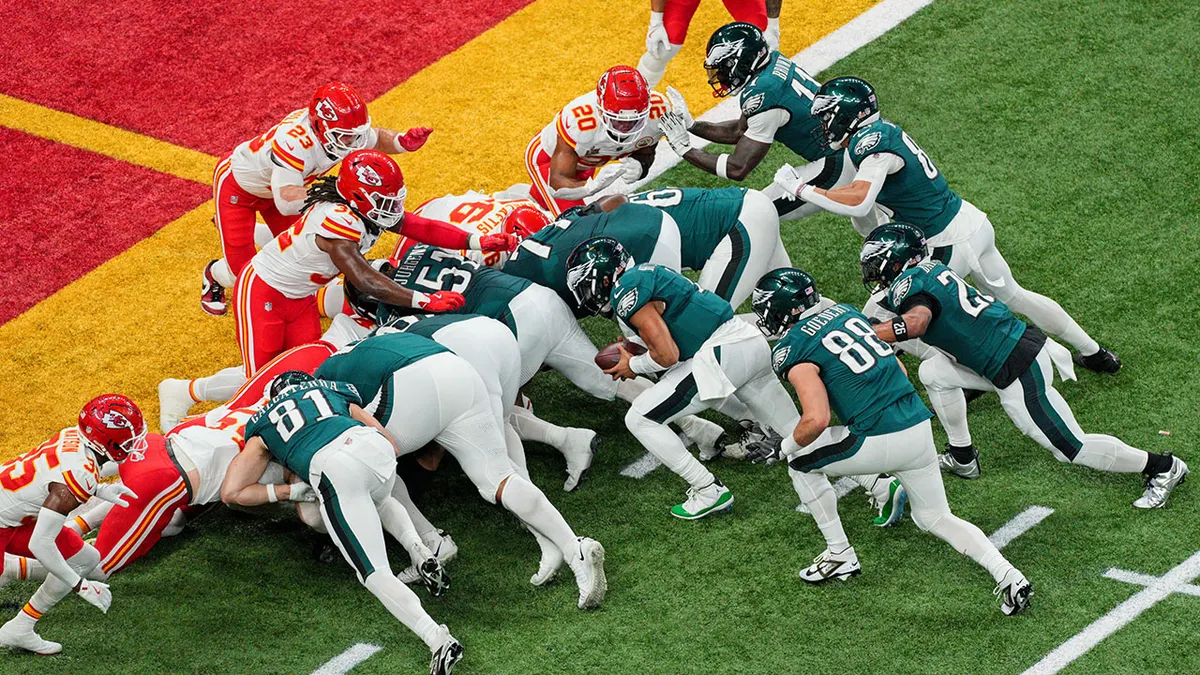By Siddhi Vinayak Misra
Copyright breezyscroll

The NFL is cracking down on the “tush-push” — the short-yardage quarterback sneak made famous by the Philadelphia Eagles, after officials were instructed to apply stricter oversight during games this season.
The league released a training tape to referees this week, highlighting examples from the Eagles’ Week 2 clash with the Kansas City Chiefs, including quarterback Jalen Hurts’ late-game sneak in a rematch of Super Bowl LVII. The Eagles won 20-17, but the film underscored moments where officials missed infractions tied to the tactic.
What is the ‘tush-push’?
The play involves the quarterback sneaking forward on short yardage downs while teammates push from behind to drive the pile.
It has become nearly synonymous with the Eagles, who boast a 96.6% conversion rate on 4th-and-1 since 2022 when using it.
Supporters hail it as a legitimate, hard-nosed football play, while critics argue it creates an unfair competitive edge.
The play’s effectiveness sparked league-wide debate during the offseason. A proposal to ban it narrowly failed when owners voted 22–10 to keep it legal — two votes shy of the 24 required to outlaw it.
What did the NFL say?
NFL vice president of officiating training and development Ramon George stressed that officials must be “black and white” in enforcing rules during short-yardage bunch formations.
“Anytime we have this situation in short yardage, we know we want to make sure that we officiate these plays; the offensive team has to be perfect in every aspect,” George said, per the Washington Post. “We want to officiate it tight. We want to be as precise as we can when teams are in a bunch position, making sure they’re onside and not moving early.”
In other words, while the play remains legal, referees have been told to scrutinize every detail, from pre-snap alignment to early movement, to prevent teams from gaining undue advantage.
Why is the play so controversial?
Competitive imbalance: The success rate makes defensive stops nearly impossible in short-yardage situations.
Injury concerns: The pile-driving motion has raised questions about increased risks for both offensive and defensive linemen.
Tradition vs. innovation: Critics see it as exploiting a loophole, while defenders argue it’s simply smart football within the rules.
The debate echoes past NFL controversies, such as the outlawing of the wedge block on kickoffs for safety reasons.
How are teams reacting?
Despite heavy criticism, many coaches have defended the Eagles’ innovation. The fact that the play survived the offseason vote reflects a divided league: some franchises see banning it as unnecessary, while others believe it undermines defensive competitiveness.
For now, the Eagles and other teams can continue to use the play, but they’ll be under a much sharper officiating microscope.
Why this matters for fans
The NFL’s move highlights a broader truth: football strategy evolves faster than rule enforcement. Plays like the tush-push test the balance between creativity, fairness, and safety.
If referees clamp down effectively, expect more penalties or failed conversions.
If oversight lags, the play could remain nearly automatic for teams bold enough to use it.
Fans should watch closely in high-stakes situations, particularly on 4th-and-short, where the tush-push has often shifted momentum in games.
The NFL won’t ban the Eagles’ infamous tush-push play, but referees have been told to enforce rules around it much more strictly this season. The play, essentially a quarterback sneak with teammates pushing from behind, has a near-perfect success rate but remains one of the league’s most divisive tactics. While still legal, its future may hinge on whether officials can level the playing field.



